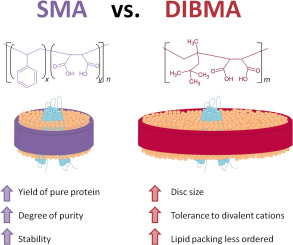当前位置:
X-MOL 学术
›
BBA Biomembr.
›
论文详情
Our official English website, www.x-mol.net, welcomes your feedback! (Note: you will need to create a separate account there.)
A comparison of SMA (styrene maleic acid) and DIBMA (di-isobutylene maleic acid) for membrane protein purification.
Biochimica et Biophysica Acta (BBA) - Biomembranes ( IF 3.4 ) Pub Date : 2020-03-21 , DOI: 10.1016/j.bbamem.2020.183281 Aiman A Gulamhussein 1 , Romez Uddin 1 , Brian J Tighe 2 , David R Poyner 1 , Alice J Rothnie 1
Biochimica et Biophysica Acta (BBA) - Biomembranes ( IF 3.4 ) Pub Date : 2020-03-21 , DOI: 10.1016/j.bbamem.2020.183281 Aiman A Gulamhussein 1 , Romez Uddin 1 , Brian J Tighe 2 , David R Poyner 1 , Alice J Rothnie 1
Affiliation

|
The use of styrene maleic acid co-polymer (SMA) for membrane protein extraction and purification has grown in recent years. SMA inserts in the membrane and assembles into small discs of bilayer encircled by polymer, termed SMA lipid particles (SMALPs). This allows purification of membrane proteins whilst maintaining their lipid bilayer environment. SMALPs offer several improvements over conventional detergent approaches, however there are limitations, most notably a sensitivity to low pH and divalent cations. Recently it was shown that the aliphatic diisobutylene-maleic acid (DIBMA) copolymer, was also able to directly solubilise membranes forming DIBMALPs (DIBMA lipid particles), and that this polymer overcame some of the limitations of SMA. In this study the ability of DIBMA to solubilise and purify functional membrane proteins has been compared to SMA. It was found that DIBMA is able to solubilise several different membrane proteins from different expression systems, however for some proteins it gives a lower yield and lower degree of purity than SMA. DIBMA extracted G protein-coupled receptors retain ligand- and G protein-binding. DIBMALPS are larger than SMALPs and display a decreased sensitivity to magnesium. However the stability of DIBMALPs appears to be lower than SMALPs. The lower purity and lower stability are likely linked to the larger size of the DIBMALP particle. However, this also offers a potentially less rigid lipid environment which may be more amenable to protein dynamics. Therefore the optimal choice of polymer will depend on which features of a protein are to be investigated.
中文翻译:

SMA(苯乙烯马来酸)和DIBMA(二异丁烯马来酸)用于膜蛋白纯化的比较。
近年来,苯乙烯马来酸共聚物(SMA)用于膜蛋白提取和纯化的用途已越来越多。SMA插入膜中并组装成被聚合物包围的双层小圆盘,称为SMA脂质颗粒(SMALP)。这样可以纯化膜蛋白,同时保持其脂质双层环境。SMALP与常规洗涤剂方法相比有一些改进,但是存在局限性,最明显的是对低pH和二价阳离子的敏感性。最近显示,脂族二异丁烯-马来酸(DIBMA)共聚物也能够直接溶解形成DIBMALP(DIBMA脂质颗粒)的膜,并且这种聚合物克服了SMA的某些局限性。在这项研究中,DIBMA溶解和纯化功能性膜蛋白的能力已与SMA进行了比较。发现DIBMA能够溶解来自不同表达系统的几种不同的膜蛋白,但是对于某些蛋白,它的收率和纯度均低于SMA。DIBMA提取的G蛋白偶联受体保留配体和G蛋白结合。DIBMALPS比SMALP大,并且对镁的敏感性降低。但是,DIBMALP的稳定性似乎低于SMALP。较低的纯度和较低的稳定性可能与DIBMALP颗粒的较大尺寸有关。然而,这也提供了潜在的刚性较差的脂质环境,其可能更适合蛋白质动力学。
更新日期:2020-03-22
中文翻译:

SMA(苯乙烯马来酸)和DIBMA(二异丁烯马来酸)用于膜蛋白纯化的比较。
近年来,苯乙烯马来酸共聚物(SMA)用于膜蛋白提取和纯化的用途已越来越多。SMA插入膜中并组装成被聚合物包围的双层小圆盘,称为SMA脂质颗粒(SMALP)。这样可以纯化膜蛋白,同时保持其脂质双层环境。SMALP与常规洗涤剂方法相比有一些改进,但是存在局限性,最明显的是对低pH和二价阳离子的敏感性。最近显示,脂族二异丁烯-马来酸(DIBMA)共聚物也能够直接溶解形成DIBMALP(DIBMA脂质颗粒)的膜,并且这种聚合物克服了SMA的某些局限性。在这项研究中,DIBMA溶解和纯化功能性膜蛋白的能力已与SMA进行了比较。发现DIBMA能够溶解来自不同表达系统的几种不同的膜蛋白,但是对于某些蛋白,它的收率和纯度均低于SMA。DIBMA提取的G蛋白偶联受体保留配体和G蛋白结合。DIBMALPS比SMALP大,并且对镁的敏感性降低。但是,DIBMALP的稳定性似乎低于SMALP。较低的纯度和较低的稳定性可能与DIBMALP颗粒的较大尺寸有关。然而,这也提供了潜在的刚性较差的脂质环境,其可能更适合蛋白质动力学。

























 京公网安备 11010802027423号
京公网安备 11010802027423号